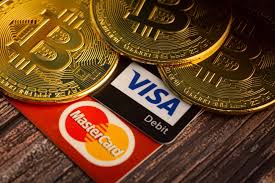Cryptomomen.com – In the dynamic fintech landscape, Visa, Mastercard, and blockchain technology are engaging in an evolving dance.
As global payment giants, Visa and Mastercard have established dominance in the traditional financial ecosystem. However, the emergence of blockchain has introduced a disruptive force, challenging existing paradigms.
The intersection of these three players is shaping the future of payments, fostering innovation, and unlocking new possibilities. To unravel this complex relationship, we delve into the motivations, collaborations, and challenges that characterize this transformative landscape.
Continue reading to witness how Visa, Mastercard, and blockchain are redefining the payment industry and paving the way for a more interconnected and secure financial future.
Introduction
Blockchain, a groundbreaking technology, is rapidly reshaping traditional finance by introducing novel solutions to longstanding challenges.
Its decentralized and immutable nature enables secure and transparent transactions, reducing the need for intermediaries and minimizing fraud risks.
Additionally, blockchain-based smart contracts automate complex processes, eliminating manual errors and improving efficiency.
As a result, the integration of blockchain into traditional finance is poised to revolutionize the way financial transactions are conducted, fostering greater trust, transparency, and efficiency within the financial ecosystem.
Thank you for visiting Cryptomomen.com
Overview of Visa, Mastercard, and Blockchain
Visa, Mastercard, and blockchain technology are converging to revolutionize the financial landscape.
Visa and Mastercard, the leading credit card companies, are integrating blockchain into their systems to enhance security, streamline cross-border transactions, and facilitate real-time settlements.
Simultaneously, blockchain is disrupting traditional banking models by offering decentralized, secure, and transparent platforms for financial transactions.
By leveraging blockchain, Visa and Mastercard aim to increase efficiency, reduce costs, and explore new revenue streams.
This integration has the potential to reshape the financial industry, fostering greater accessibility, inclusivity, and innovation.
The evolving relationship between the three
The relationship between blockchain and traditional finance is evolving, with the two sides increasingly integrating to create innovative solutions.
Initially, traditional finance viewed blockchain with skepticism, but as the technology matured, it became clear that it could offer benefits such as increased security, transparency, and efficiency.
Step by step, traditional financial institutions have begun to adopt blockchain technology, either directly or through partnerships with technology companies.
As the integration between blockchain and traditional finance continues to deepen, it has the potential to revolutionize the financial industry, creating new opportunities for growth and innovation.
Visa’s early experiments with blockchain
Visa’s early experiments with blockchain played a pivotal role in the evolution of the payments industry.
The company recognized the potential of this transformative technology to streamline and enhance traditional financial processes.
By leveraging blockchain’s immutable ledger and consensus mechanisms, Visa aimed to reduce transaction costs, increase transparency, and enhance security.
Notable projects included the Visa B2B Connect platform, designed to facilitate secure cross-border payments, and the Universal Payments initiative, which sought to enable frictionless global commerce.
These pioneering efforts not only shaped Visa’s own technological capabilities but also laid the foundation for broader adoption of blockchain within the fintech space.
As one executive put it, “Blockchain is a game-changer for the payments industry, offering a secure and efficient way to transfer funds and assets.
We are excited to continue investing in this revolutionary technology.
Visa’s current blockchain initiatives
Visa has forged ahead in the realm of blockchain technology, initiating numerous strategic partnerships and development projects aimed at revolutionizing traditional finance.
As a global leader in payments, Visa has recognized the transformative potential of blockchain to enhance security, transparency, and efficiency across financial ecosystems.
One notable initiative is the Visa B2B Connect platform, which leverages blockchain to streamline cross-border payments between businesses globally, reducing friction and transaction costs while providing real-time visibility into payment status.
Visa has also collaborated with a vast network of financial institutions, fintechs, and technology providers to develop blockchain-enabled solutions tailored to specific industry needs.
These initiatives range from enhancing fraud detection and compliance processes to facilitating cross-currency settlements and enabling new digital payment experiences.
By seamlessly integrating blockchain into its existing infrastructure, Visa is unlocking the potential of decentralized technologies to reshape traditional finance, creating a more secure, efficient, and accessible financial system for all stakeholders.
Benefits and challenges of Visa’s blockchain partnerships
Visa’s partnerships with blockchain companies can foster innovation and efficiency in financial services.
Integrating blockchain technology enables Visa to explore new payment channels, enhance cross-border transactions, and streamline operations.
For instance, partnering with R3 Corda allows Visa to develop a private network for instant interbank settlements.
However, these partnerships present challenges as well. Regulatory frameworks need to evolve to accommodate blockchain’s decentralized nature, and security concerns must be addressed to maintain trust in the financial ecosystem.
Striking a balance between innovation and compliance remains crucial.
Mastercard’s Relationship with Blockchain
Mastercard, a financial services giant, is forging a path towards the integration of blockchain with traditional finance.
This partnership brings three fundamental benefits: Increased Security: Blockchain’s decentralized and immutable ledger ensures the secure storage and traceability of transactions.
Enhanced Efficiency: Automation and smart contracts streamline processes, reducing costs and errors.
New Opportunities: Blockchain enables the creation of innovative financial products and services, fostering growth and innovation within the industry.
Mastercard’s early experiments with blockchain
Mastercard has been actively exploring the potential of blockchain technology to enhance traditional finance.
In 2016, the company partnered with IBM to launch a blockchain-based solution for cross-border payments, dubbed “Blockchain World Wire”.
This platform enabled near-instant, low-cost transactions between banks in different countries.
Mastercard has also invested in blockchain startups and collaborated with other industry players to develop new applications.
For example, in 2019, Mastercard joined the R3 Corda consortium, a group of financial institutions working together to explore blockchain-based solutions for trade finance and other areas.
Mastercard’s early experiments with blockchain showcase the company’s commitment to innovation and its recognition of the potential benefits of this disruptive technology for the financial industry.
Closing Words
As the lines between traditional finance and blockchain technology continue to blur, Visa and Mastercard’s embrace of blockchain indicates a shift towards a more integrated financial landscape.
Their strategic partnerships and ongoing initiatives demonstrate a recognition of blockchain’s potential to enhance security, automate processes, and facilitate cross-border transactions.
With the development of central bank digital currencies and the increasing adoption of blockchain solutions, the relationship between these financial giants and blockchain technology will undoubtedly continue to evolve, shaping the future of finance.
“The future of money is digital, and the future of digital money is blockchain.”



